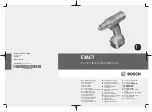
13
For high speeds (H), move the switch (6) forward.
Use this mode for adjusting screws or drilling large
diameter holes.
For low speeds (L), move the switch (6) backward.
Use this mode for drilling speeds to make small
diameter holes.
Selecting the rotational direction
Change the rotational direction only
after the motor comes to a complete
stop. Otherwise, it could damage the
power tool.
Clockwise rotation
(drilling, screw extraction) Set
the rotational direction selector switch (8) to the
left (Fig. 4).
Counter-clockwise rotation
(screw extraction) Set
the rotational direction selector switch (8) to the
right (Fig. 4).
Deceleration
Deceleration stops the quick change chuck (1) im-
mediately after the power tool has been switched
off. This helps prevent excessive tightening of the
bolts and screws and prevents damage to the work
attachments, the screwdriver bits and the slots on the
setting elements.
11. OPERATIONAL TIPS
Boring and drilling (Fig. 8-9)
• Grease the bits periodically when drilling holes in
metals (except when drilling non-ferrous metals and
their alloys).
• When drilling hard metals, apply more force to the
power tool and lower the rotation speed.
• When drilling large diameter holes in metal, first drill
a smaller diameter hole and expand it to the required
diameter (Fig. 8).
• Follow these instructions to avoid surfaces from
cracking at the tool bit's exit point when drilling holes
in the wood, as shown in (Fig. 9).
• Take the following measures to reduce dust from
drilling holes in walls and ceilings, as indicated in
(Figs. 5-6).
How to screw in screws (Fig. 7)
• First drill a hole with a diameter equal to 2/3 of the
screw’s diameter to make it easier to tighten the screws
and prevent work attachment breakage.
• Take the following measures to make a durable,
uncracked, unfractured, even joint, if you join work
pieces using screws, as shown in (Fig. 7)
12. POWER TOOL MAINTENANCE / PREVEN-
TATIVE MEASURES
Before carrying out any procedure, centre the rota-
tional direction selector switch (8) to lock the switch
and prevent the tool's untimely start-up.
Battery maintenance instructions
• Carry out charging in a timely manner, before the
battery is completely drained. Stop operating when it
is at low power and charge it immediately.
• Do not overcharge the battery when the battery is fu-
lly charged, otherwise its service life will be shortened.
• Charge the battery at room temperatures of 10ºC
to 40ºC (50ºF to 104ºF).
• Charge the battery every 6 months, if you have not
used the tool for an extended period.
• Replace used batteries in a timely fashion. Decreased
working time indicates that the battery is worn out
and needs to be replaced. Take into account that the
battery can be drain faster if the work is carried out
at temperatures below 0°C.
• If unused and stored for an extended period, the
machine should be stored at room temperature,
without the battery and with the battery charged.
Cleaning the power tool
Keeping the power tool clean is a crucial condition for a
long-term, safe usage. Clean the tool with compressed
air frequently through the ventilation slots (9).
13. HOW TO TRANSPORT POWER TOOLS
• Do not drop the tool to avoid blows that may
damage the tool.
• Always transport the tool in its original transport case.
Li-Ion batteries
The built-in Li-Ion battery is subject to the requirements
of the legislation on dangerous goods
The user can transport the batteries by road without
any additional requirements.
When transported by third parties (e.g. air transport
or carrier agency), the special packaging and labelling
requirements must be observed.
It is necessary to consult a hazardous materials expert
to prepare the item that is to be shipped.
Only send batteries when the housing is in good
condition. Tape or cover the open contacts and pack
the battery in such a way that it cannot move in the
packaging. Keep in mind that national regulations
might be more detailed.
14. NOISE AND VIBRATION LEVEL
The noise and vibration levels of this device have
been measured in accordance with European














































